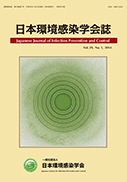
- Issue 6 Pages 271-
- Issue 5 Pages 237-
- Issue 4 Pages 215-
- Issue 3 Pages 129-
- Issue 2 Pages 75-
- Issue 1 Pages 1-
- |<
- <
- 1
- >
- >|
-
Kayoko HAYAKAWA, Taichi TAJIMA, Yoshiki KUSAMA, Nobuaki MATSUNAGA, Sah ...2019Volume 34Issue 4 Pages 215-221
Published: July 25, 2019
Released on J-STAGE: January 24, 2020
JOURNAL FREE ACCESSDownload PDF (2144K) -
Ichiro KAWAMURA2019Volume 34Issue 4 Pages 222-226
Published: July 25, 2019
Released on J-STAGE: January 24, 2020
JOURNAL FREE ACCESSSurveillance in healthcare settings is a critically important component of any multidrug-resistant organisms (MDROs) control program and is useful for antimicrobial stewardship as well as infection control. Considering the circumstances where the activities of antimicrobial stewardship have recently begun in Japan, antimicrobial stewardship teams may not only monitor patients isolated with MDROs but may also assess the susceptibility patterns of MDROs in most healthcare facilities. This document describes useful and practical surveillance metrics of MDROs for antimicrobial stewardship program in healthcare settings.
View full abstractDownload PDF (316K)
-
Tatsuro MITSUHASHI, Ryuichi HIRANO, Katsuyoshi OSANAI, Junichi KITAZAW ...2019Volume 34Issue 4 Pages 227-233
Published: July 25, 2019
Released on J-STAGE: January 24, 2020
JOURNAL FREE ACCESS[Background] Staphylococcus aureus bacteremia (SAB) is known as an important nosocomial infection owing to its high mortality rate. We compared treatment items and survival rate among patients diagnosed with SAB pre- and post- to evaluate the effect of the intervention by the multidisciplinary antimicrobial stewardship team (AST) in our hospital.
[Methods] The intervention was implemented from April 2015. In total, 102 patients diagnosed with SAB were enrolled in this study: 50 patients enrolled between January 2014 and December 2014 comprised the pre-intervention group, and 52 patients enrolled between January 2016 and December 2016 comprised the post-intervention group.
We evaluated the survival rate and the achievement rate of the proposed bundles for patients with SAB using a hospital telephone as well as a tag function of an electronic medical chart provided by AST.
[Results] A significant difference was observed in the proportion of echocardiography procedures conducted to rule out infective endocarditis (pre-intervention, 22.5% vs. post-intervention, 75%), follow-up blood culture tests to confirm the clearance of bacteria (pre-intervention, 45% vs. post-intervention, 82.5%), and >14 days of therapy using antibiotics that exhibited susceptibility to the isolated bacteria (pre-intervention, 42.5% vs. post-intervention, 75%). No significant difference was observed in the 30-day survival rate (pre-intervention, 73.8% vs. post-intervention 74.4%).
[Conclusion] Our multidisciplinary intervention was efficient in implementing medical procedures required to evaluate complicated SAB. Although no significant difference was observed in the survival rate, our intervention without the board-certified membership of the Japanese Association for Infectious Diseases contributed to the improvement of process indicators among patients with SAB.
View full abstractDownload PDF (348K)
-
Naoko NAKAGI, Eiji OHARA2019Volume 34Issue 4 Pages 234-236
Published: July 25, 2019
Released on J-STAGE: January 24, 2020
JOURNAL FREE ACCESSThe primary objective of any food service is to provide its beneficiaries with healthy and hearty meals. To this end, meals should primarily be hygienic and safe. Microorganisms such as viruses that cause food poisoning are transferred into cooking facilities via food materials or the skin, clothes, and footwear of cooking staff and tableware. Considering facility hygiene, no reports have focused on the contamination of white coats (cooking jackets). Therefore, we investigated the prevalence of contamination of white coats before and after volume cooking (≥100 meals at a time) to explore the possibility of food poisoning transmitted via white coats worn by students at a school for dietitians/nutritionists. The swab and stamp methods were employed for the investigation, targeting the cuffs and pocket openings of the coats. After volume cooking, contamination was confirmed on the cuffs, suggesting the possibility of general bacterial contamination. As part of hygiene education, it is essential to teach students the importance of wearing clean white coats.
View full abstractDownload PDF (273K)
- |<
- <
- 1
- >
- >|